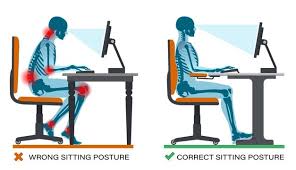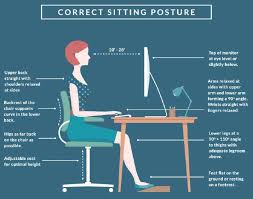

If you spend hours sitting at your desk, you might have noticed some discomfort in your neck or upper back.
What you may not realize is that this discomfort could be a sign of forward head posture, also known as “text neck” or “nerd neck.”
Forward head posture is a condition where your head juts out in front of your shoulders, leading to strain on your neck muscles and spine.
Could the way you sit at your desk be to blame? Even more importantly, can fixing your office ergonomics help correct this posture?
The surprising answer is yes—but only if you understand how to set up your workstation properly.
This article will uncover the truth behind office ergonomics and forward head posture, offering practical solutions that can help.
“Can Office Ergonomics Really Fix Your Forward Head Posture” Article Contents:
- What Is Forward Head Posture?
- The Role of Office Ergonomics in Posture Correction
- Best Posture for Sitting at a Desk
- How Proper Desk Posture Prevents Forward Head Posture
- Good Desk Posture: The Ergonomic Way of Sitting at a Desk
- Ideal Desk Posture: Simple Adjustments for Big Improvements
- The Best Computer Desk Posture for Neck Health
- Can the Best Desk for Posture Really Fix Forward Head Posture?
- FAQs on How to Fix Forward Neck via Office Ergonomics
- Conclusion: Can Office Ergonomics Fix Forward Head Posture?
What Is Forward Head Posture?
Forward head posture occurs when the head shifts forward from its natural alignment with the spine.
Ideally, your ears should be directly over your shoulders when standing or sitting. However, due to prolonged desk work, this posture can easily be compromised, leading to excessive strain on the neck and upper back muscles.
This misalignment can result in a host of issues, including headaches, muscle tension, and even long-term spinal damage.
A study published in the Journal of Physical Therapy Science found that forward head posture can increase the pressure on the cervical spine by as much as 60 pounds.
This explains why many desk workers experience chronic neck pain after years of poor posture habits. The good news is that with the right ergonomic setup, you can alleviate or even reverse this condition.
The Role of Office Ergonomics in Posture Correction
Office ergonomics refers to designing your workspace to promote good posture and reduce the risk of musculoskeletal problems.
With the proper ergonomic setup, you can position your body in a way that encourages optimal alignment of your spine, head, and shoulders. This is especially important if you spend long hours sitting at a desk.
The concept of ergonomics goes beyond just a comfortable chair or desk; it involves every aspect of your work environment, from the height of your monitor to the placement of your keyboard.
Studies have shown that adjusting these factors can improve posture, decrease neck strain, and help prevent conditions like forward head posture.
Best Posture for Sitting at a Desk
The best posture for sitting at a desk starts with keeping your feet flat on the floor and your knees at a 90-degree angle.
Your back should be supported by the backrest of your chair, and your hips should be positioned slightly above your knees. This positioning helps maintain the natural curve of your spine.
According to the Ergonomics Journal, one of the key elements of good desk posture is making sure that your head is aligned with your spine.
Your computer monitor should be at eye level, so you do not need to tilt your head down or up. Keeping your head in line with your spine can reduce the strain that leads to forward head posture.
How Proper Desk Posture Prevents Forward Head Posture
“Proper desk posture” involves more than just sitting upright; it requires attention to how your entire body is positioned throughout the day.
When your desk posture is incorrect, especially when your head is constantly pushed forward to view a screen, the muscles in your neck work overtime to support the weight of your head. Over time, this leads to forward head posture.
The Occupational Health and Safety Journal highlights that regularly practicing proper desk posture can help prevent this.
By positioning your computer screen at eye level, keeping your elbows close to your body, and making sure your feet are flat on the ground, you distribute your body’s weight evenly, reducing strain on your neck and back muscles.
Good Desk Posture: The Ergonomic Way of Sitting at a Desk
“Ergonomic sitting posture” is key to improving your overall health and avoiding posture problems.
Ergonomics encourages sitting in a way that minimizes stress on your body while maximizing productivity.
To achieve the ergonomic way of sitting at a desk, follow these steps:
- Adjust your chair so your feet rest flat on the floor.
- Keep your knees bent at about a 90-degree angle.
- Make sure your lower back is supported by your chair’s lumbar support.
- Position your keyboard so your elbows are at a 90-degree angle.
- Keep your wrists in a neutral position.
Implementing this “ergonomic sitting at desk” setup can help alleviate the tension that contributes to forward head posture.
A study in the Journal of Applied Ergonomics confirmed that workers who adopted ergonomic sitting posture experienced reduced muscle fatigue and lower incidences of neck strain.
Ideal Desk Posture: Simple Adjustments for Big Improvements
The “ideal desk posture” for forward head posture involves positioning your desk, chair, and computer in a way that promotes spinal alignment.
Your computer screen should be at eye level, about 20-30 inches from your face. If your screen is too low, you’re more likely to lean forward, pushing your head out of alignment.
Similarly, your chair should provide proper support for your lower back, and your desk height should allow your arms to rest comfortably at a 90-degree angle.
According to research published in the International Journal of Occupational Medicine and Environmental Health, these small adjustments can make a significant difference in preventing and correcting posture-related issues.
The Best Computer Desk Posture for Neck Health
Monitor Positioning
- The screen should be placed directly in front of you, with the top of the monitor at or slightly below eye level to encourage a neutral head position.
- According to Mayo Clinic, keeping the screen at arm’s length helps reduce the tendency to lean forward, which can strain the neck (Mayo Clinic, 2024).
- UCLA Health recommends positioning the monitor at a comfortable distance to prevent unnecessary head tilting and forward head posture (UCLA Health, 2024).
Chair Selection and Adjustment
- Using an ergonomic chair with lumbar support helps maintain the natural curve of the spine and prevents slouching.
- Mayo Clinic states that adjusting the chair height so that feet rest flat on the floor and thighs remain parallel to the ground can prevent excessive neck and back strain (Mayo Clinic, 2024).
- GoodPath advises ensuring that the backrest supports the lower back, promoting a more upright posture throughout the day (GoodPath, 2024).
Desk Configuration
- HealthFit Chiropractic emphasizes that the desk height should allow forearms to rest comfortably, keeping shoulders relaxed and reducing muscle fatigue (HealthFit Chiropractic, 2024).
- Complete Pilates suggests choosing a desk with adequate depth to support elbow positioning and prevent reaching, which can cause additional strain (Complete Pilates, 2024).
Keyboard and Mouse Placement
- The keyboard and mouse should be positioned at elbow height, allowing wrists to stay straight while typing.
- Towson Chiropractic recommends placing these devices close to prevent overreaching and unnecessary tension in the shoulders and neck (Towson Chiropractic, 2024).
- HealthFit Chiropractic suggests using a wrist rest or an ergonomic keyboard to promote better hand and arm alignment (HealthFit Chiropractic, 2024).
Incorporating Movement
- Spine-Health advises taking short breaks every hour to stand up, stretch, and move around to reduce muscle fatigue and improve circulation (Spine-Health, 2024).
- Regular stretching exercises for the neck and shoulders (neck stretches or shoulder stretches) can help prevent stiffness and improve posture over time.
Awareness of Posture
- Spine-Health suggests periodically checking that the head is aligned with the spine to avoid a forward head posture (Spine-Health, 2024).
- Using ergonomic aids such as monitor mounts can help adjust the screen height and angle, ensuring a neutral neck position.
Maintaining the correct computer desk posture is essential for preventing neck pain and promoting overall well-being.
A study published in the Journal of Ergonomic Science found that workers who followed ergonomic recommendations experienced fewer neck problems compared to those with improper desk setups.
By optimizing your workstation with the right chair, desk, monitor, and ergonomic accessories, along with regular movement and posture awareness, you can significantly improve neck health and workplace comfort.
FAQs on How to Fix Forward Neck via Office Ergonomics
Q1: How does forward head posture (FHP) affect office workers’ health?
A1: Forward head posture (FHP) is a common condition among office workers, characterized by the head protruding forward relative to the body’s vertical line. This misalignment can lead to increased muscle tension, particularly in the neck and shoulders, resulting in discomfort and potential pain. Prolonged FHP may also contribute to the development of musculoskeletal disorders, affecting overall well-being and productivity.
Q2: Can ergonomic interventions in the office environment correct forward head posture?
A2: Implementing ergonomic interventions, such as adjusting chair support, monitor height, and workstation setup, can help alleviate the strain associated with FHP. For instance, using an unstable cushion-ball seat support has been shown to reduce muscle activity in the neck and trunk, potentially decreasing the severity of FHP. Additionally, incorporating standing desks may improve craniovertebral angles, indicating a reduction in forward head posture. However, while these interventions can mitigate discomfort, they may not fully correct established FHP.
Q3: Are there specific ergonomic practices that can prevent the development of forward head posture?
A3: To prevent FHP, it’s essential to maintain proper workstation ergonomics. Ensure that the top of your monitor is at or slightly below eye level, keeping your head in a neutral position. Use a chair with adequate lumbar support to maintain the natural curve of the spine. Regular breaks and exercises to strengthen neck and upper back muscles can also be beneficial in preventing FHP.
Q4: How effective are ergonomic interventions compared to other treatments for forward head posture?
A4: While ergonomic interventions can alleviate symptoms associated with FHP, they may not be sufficient for complete correction. Combining ergonomic adjustments with physical therapy exercises targeting neck and upper back muscles has been shown to be more effective in improving posture and reducing discomfort. In some cases, the use of orthotic devices or braces may provide additional support and aid in posture correction.
Q5: Can forward head posture lead to long-term health issues if not addressed?
A5: If left unaddressed, FHP can lead to chronic neck and shoulder pain, tension headaches, and decreased range of motion. Over time, it may also contribute to the development of more serious musculoskeletal disorders, such as cervical spondylosis. Therefore, it’s crucial to implement ergonomic practices and seek appropriate treatment to prevent long-term health complications associated with FHP.
Can Office Ergonomics Really Fix Forward Head Posture?
So, can office ergonomics really fix your forward head posture?
The surprising answer is that while ergonomics alone may not completely reverse forward head posture, it plays a crucial role in prevention and alleviation.
By practicing “proper desk posture” and “ergonomic sitting at desk” habits, you can relieve the strain on your neck muscles and prevent further damage.
Incorporating an “ergonomic way of sitting at desk” into your daily routine, paired with regular movement and exercises, can make a significant difference in your posture and overall well-being.
By following these guidelines, you will not only improve your forward head posture but also reduce your risk of long-term neck and spine issues.
References:

